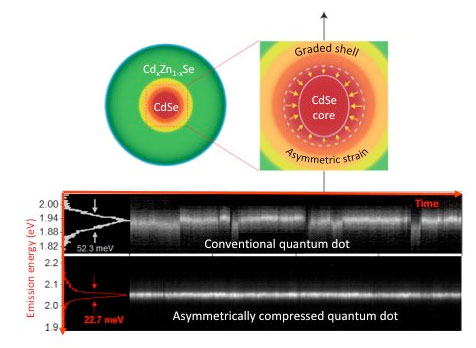| Jan 10, 2019 | |
More stable light comes from intentionally 'squashed' quantum dots(Nanowerk News) Intentionally “squashing” colloidal quantum dots during chemical synthesis creates dots capable of stable, “blink-free” light emission that is fully comparable with the light produced by dots made with more complex processes. The squashed dots emit spectrally narrow light with a highly stable intensity and a non-fluctuating emission energy. |
|
| New research at Los Alamos National Laboratory suggests that the strained colloidal quantum dots represent a viable alternative to presently employed nanoscale light sources, and they deserve exploration as single-particle, nanoscale light sources for optical “quantum” circuits, ultrasensitive sensors, and medical diagnostics. | |
| “In addition to exhibiting greatly improved performance over traditional produced quantum dots, these new strained dots could offer unprecedented flexibility in manipulating their emission color, in combination with the unusually narrow, ‘subthermal’ linewidth,” said Victor Klimov, lead Los Alamos researcher on the project. “The squashed dots also show compatibility with virtually any substrate or embedding medium as well as various chemical and biological environments.” | |
 |
|
| Novel colloidal quantum dots are formed of an emitting cadmium/selenium (Cd/Se) core enclosed into a compositionally graded CdxZn1-xSe shell wherein the fraction of zinc versus cadmium increases towards the dot's periphery. Due to a directionally asymmetric lattice mismatch between CdSe and ZnSe, the core, at top right, is compressed more strongly perpendicular to the crystal axis than along it. This leads to modifications of the electronic structure of the CdSe core, which beneficially affects its light-emission properties. Bottom image: Experimental traces of emission intensity from a conventional quantum dot (upper panel) and a novel asymmetrically compressed quantum dot (lower panel) resolved spectrally and temporally. The emission from the conventional quantum dot shows strong spectral fluctuations (“spectral jumps” and “spectral diffusion”). The emission from the asymmetrically compressed quantum dots is highly stable in both intensity and spectral domains. In addition, it shows a much narrower linewidth, which is below the room-temperature thermal energy (25 meV). (Image: Los Alamos National Laboratory) | |
| The new colloidal processing techniques allow for preparation of virtually ideal quantum-dot emitters with nearly 100 percent emission quantum yields shown for a wide range of visible, infrared and ultraviolet wavelengths. These advances have been exploited in a variety of light-emission technologies, resulting in successful commercialization of quantum-dot displays and TV sets. | |
| The next frontier is exploration of colloidal quantum dots as single-particle, nanoscale light sources. Such future “single-dot” technologies would require particles with highly stable, nonfluctuating spectral characteristics. Recently, there has been considerable progress in eliminating random variations in emission intensity by protecting a small emitting core with an especially thick outer layer. However, these thick-shell structures still exhibit strong fluctuations in emission spectra. | |
| In a new publication in the journal Nature Materials ("Asymmetrically Strained Quantum Dots with Nonfluctuating Single-Dot Emission Spectra and Subthermal Room-Temperature Linewidths"), Los Alamos researchers demonstrated that spectral fluctuations in single-dot emission can be nearly completely suppressed by applying a new method of “strain engineering.” The key in this approach is to combine in a core/shell motif two semiconductors with directionally asymmetric lattice mismatch, which results in anisotropic compression of the emitting core. | |
| This modifies the structures of electronic states of a quantum dot and thereby its light emitting properties. One implication of these changes is the realization of the regime of local charge neutrality of the emitting “exciton” state, which greatly reduces its coupling to lattice vibrations and fluctuating electrostatic environment, key to suppressing fluctuations in the emitted spectrum. | |
| An additional benefit of the modified electronic structures is dramatic narrowing of the emission linewidth, which becomes smaller than the room-temperature thermal energy. |
| Source: Los Alamos National Laboratory | |
|
Subscribe to a free copy of one of our daily Nanowerk Newsletter Email Digests with a compilation of all of the day's news. |
